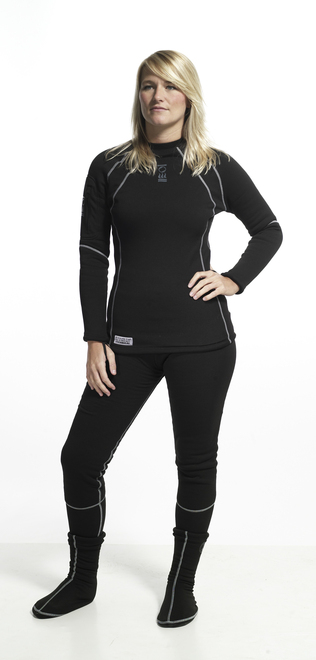When the water turns cold, drysuits become necessary for the diver who wants to keep diving. But even a neoprene drysuit won’t keep you warm in frigid water, so wearing something underneath for insulation is a must.
The standard choice has been a one-piece suit made with a synthetic-fiber lining. These work well, but have a few drawbacks, including losing a lot of their insulating capacity when they become wet. The one-piece design can also limit maneuverability, as well requiring that wearers remove it all at once, leaving you in your undies in the cold air when it’s time to put your street clothes on.
Enter Fourth Element, a British producer of dive clothes, including wetsuits, travel bags and undergarments for wearing beneath drysuits. Most of the drysuit underwear consists of individual sweatshirts, pants and socks, meaning the total cost is about the same as a one-piece suit, but with a lot of advantages.

The fabric is made of a fleece-type material, which wicks moisture away from your skin regardless of whether its sweat, condensation or water leaking into your drysuit. You stay dry and warm. It is also relatively lightweight in relation to the insulation it provides. The two-piece design means that the clothes won’t hinder your movements as much as a one-piece would. And dressing and undressing can be done piecemeal, leaving you less exposed.
I did a number of dives in the suit, and it works brilliantly in temperatures ranging from around the 60 F, or 15 C, range and down to about 45 F, or 8 C, on its own, and works even better when combined with other insulating layers. I did a dive in 28 F, or minus 2 C, wearing a base layer of moisture-wicking underwear (long sleeves and legs), a thin, insulating layer (in this case the “little brother” series of the Arctic, called Xerotherm), and the Arctic, and I was quite comfortable. And, because it looks and wears more like normal clothes, the sweatshirt can be worn between dives as a normal, if very warm, sweatshirt. You may even find yourself wearing it around the house on cold days.
The series of products is not cheap, and for total protection, you’ll need socks, pants and a sweatshirt. Keep in mind though that the total cost doesn’t exceed that of most high-quality one-piece options. If you decide to buy the underwear, ensure that the pants and sweatshirt don’t gap in the middle when you stretch, as this can expose a midriff where you’ll have little or no protection from the cold, and fit can be hard to adjust once your drysuit is on.

Overall, the Fourth Element Arctic can do wonders in terms of keeping you warm and comfortable on any of your cold-water dives.
Pros
- Low buoyancy in relation to insulation properties
- Lightweight
- Good moisture-wicking properties
- Maintains good insulation properties even when wet or damp
- Modular, which allows for combinations with other products, and allows for better range of motion
Cons
- Cost is relatively high
- A number of products are needed for complete protection
- Pants-and-sweatshirt design can result in bare midriff under drysuit
Bottom line:
A good choice for the cold-water diver looking for protection from the cold exposure.
Images copyright Fourth Element


